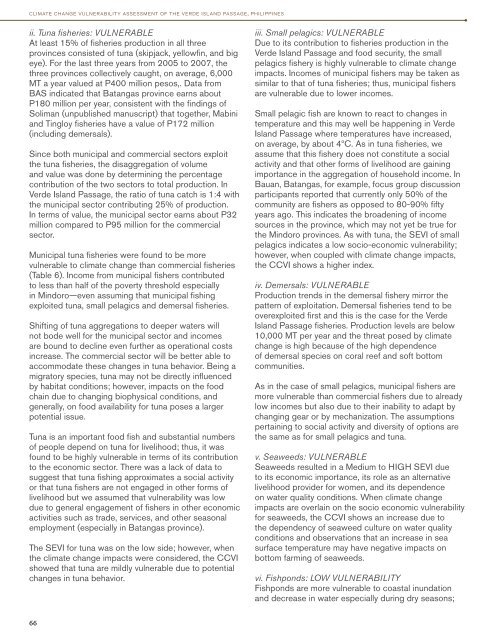of the Verde Island Passage, Philippines - weADAPT
of the Verde Island Passage, Philippines - weADAPT
of the Verde Island Passage, Philippines - weADAPT
You also want an ePaper? Increase the reach of your titles
YUMPU automatically turns print PDFs into web optimized ePapers that Google loves.
climate change vulnerability assessment <strong>of</strong> <strong>the</strong> verde island passage, philippines<br />
ii. Tuna fisheries: VULNERABLE<br />
At least 15% <strong>of</strong> fisheries production in all three<br />
provinces consisted <strong>of</strong> tuna (skipjack, yellowfin, and big<br />
eye). For <strong>the</strong> last three years from 2005 to 2007, <strong>the</strong><br />
three provinces collectively caught, on average, 6,000<br />
MT a year valued at P400 million pesos,. Data from<br />
BAS indicated that Batangas province earns about<br />
P180 million per year, consistent with <strong>the</strong> findings <strong>of</strong><br />
Soliman (unpublished manuscript) that toge<strong>the</strong>r, Mabini<br />
and Tingloy fisheries have a value <strong>of</strong> P172 million<br />
(including demersals).<br />
Since both municipal and commercial sectors exploit<br />
<strong>the</strong> tuna fisheries, <strong>the</strong> disaggregation <strong>of</strong> volume<br />
and value was done by determining <strong>the</strong> percentage<br />
contribution <strong>of</strong> <strong>the</strong> two sectors to total production. In<br />
<strong>Verde</strong> <strong>Island</strong> <strong>Passage</strong>, <strong>the</strong> ratio <strong>of</strong> tuna catch is 1:4 with<br />
<strong>the</strong> municipal sector contributing 25% <strong>of</strong> production.<br />
In terms <strong>of</strong> value, <strong>the</strong> municipal sector earns about P32<br />
million compared to P95 million for <strong>the</strong> commercial<br />
sector.<br />
Municipal tuna fisheries were found to be more<br />
vulnerable to climate change than commercial fisheries<br />
(Table 6). Income from municipal fishers contributed<br />
to less than half <strong>of</strong> <strong>the</strong> poverty threshold especially<br />
in Mindoro—even assuming that municipal fishing<br />
exploited tuna, small pelagics and demersal fisheries.<br />
Shifting <strong>of</strong> tuna aggregations to deeper waters will<br />
not bode well for <strong>the</strong> municipal sector and incomes<br />
are bound to decline even fur<strong>the</strong>r as operational costs<br />
increase. The commercial sector will be better able to<br />
accommodate <strong>the</strong>se changes in tuna behavior. Being a<br />
migratory species, tuna may not be directly influenced<br />
by habitat conditions; however, impacts on <strong>the</strong> food<br />
chain due to changing biophysical conditions, and<br />
generally, on food availability for tuna poses a larger<br />
potential issue.<br />
Tuna is an important food fish and substantial numbers<br />
<strong>of</strong> people depend on tuna for livelihood; thus, it was<br />
found to be highly vulnerable in terms <strong>of</strong> its contribution<br />
to <strong>the</strong> economic sector. There was a lack <strong>of</strong> data to<br />
suggest that tuna fishing approximates a social activity<br />
or that tuna fishers are not engaged in o<strong>the</strong>r forms <strong>of</strong><br />
livelihood but we assumed that vulnerability was low<br />
due to general engagement <strong>of</strong> fishers in o<strong>the</strong>r economic<br />
activities such as trade, services, and o<strong>the</strong>r seasonal<br />
employment (especially in Batangas province).<br />
The SEVI for tuna was on <strong>the</strong> low side; however, when<br />
<strong>the</strong> climate change impacts were considered, <strong>the</strong> CCVI<br />
showed that tuna are mildly vulnerable due to potential<br />
changes in tuna behavior.<br />
iii. Small pelagics: VULNERABLE<br />
Due to its contribution to fisheries production in <strong>the</strong><br />
<strong>Verde</strong> <strong>Island</strong> <strong>Passage</strong> and food security, <strong>the</strong> small<br />
pelagics fishery is highly vulnerable to climate change<br />
impacts. Incomes <strong>of</strong> municipal fishers may be taken as<br />
similar to that <strong>of</strong> tuna fisheries; thus, municipal fishers<br />
are vulnerable due to lower incomes.<br />
Small pelagic fish are known to react to changes in<br />
temperature and this may well be happening in <strong>Verde</strong><br />
<strong>Island</strong> <strong>Passage</strong> where temperatures have increased,<br />
on average, by about 4ºC. As in tuna fisheries, we<br />
assume that this fishery does not constitute a social<br />
activity and that o<strong>the</strong>r forms <strong>of</strong> livelihood are gaining<br />
importance in <strong>the</strong> aggregation <strong>of</strong> household income. In<br />
Bauan, Batangas, for example, focus group discussion<br />
participants reported that currently only 50% <strong>of</strong> <strong>the</strong><br />
community are fishers as opposed to 80-90% fifty<br />
years ago. This indicates <strong>the</strong> broadening <strong>of</strong> income<br />
sources in <strong>the</strong> province, which may not yet be true for<br />
<strong>the</strong> Mindoro provinces. As with tuna, <strong>the</strong> SEVI <strong>of</strong> small<br />
pelagics indicates a low socio-economic vulnerability;<br />
however, when coupled with climate change impacts,<br />
<strong>the</strong> CCVI shows a higher index.<br />
iv. Demersals: VULNERABLE<br />
Production trends in <strong>the</strong> demersal fishery mirror <strong>the</strong><br />
pattern <strong>of</strong> exploitation. Demersal fisheries tend to be<br />
overexploited first and this is <strong>the</strong> case for <strong>the</strong> <strong>Verde</strong><br />
<strong>Island</strong> <strong>Passage</strong> fisheries. Production levels are below<br />
10,000 MT per year and <strong>the</strong> threat posed by climate<br />
change is high because <strong>of</strong> <strong>the</strong> high dependence<br />
<strong>of</strong> demersal species on coral reef and s<strong>of</strong>t bottom<br />
communities.<br />
As in <strong>the</strong> case <strong>of</strong> small pelagics, municipal fishers are<br />
more vulnerable than commercial fishers due to already<br />
low incomes but also due to <strong>the</strong>ir inability to adapt by<br />
changing gear or by mechanization. The assumptions<br />
pertaining to social activity and diversity <strong>of</strong> options are<br />
<strong>the</strong> same as for small pelagics and tuna.<br />
v. Seaweeds: VULNERABLE<br />
Seaweeds resulted in a Medium to HIGH SEVI due<br />
to its economic importance, its role as an alternative<br />
livelihood provider for women, and its dependence<br />
on water quality conditions. When climate change<br />
impacts are overlain on <strong>the</strong> socio economic vulnerability<br />
for seaweeds, <strong>the</strong> CCVI shows an increase due to<br />
<strong>the</strong> dependency <strong>of</strong> seaweed culture on water quality<br />
conditions and observations that an increase in sea<br />
surface temperature may have negative impacts on<br />
bottom farming <strong>of</strong> seaweeds.<br />
vi. Fishponds: LOW VULNERABILITY<br />
Fishponds are more vulnerable to coastal inundation<br />
and decrease in water especially during dry seasons;<br />
66
















